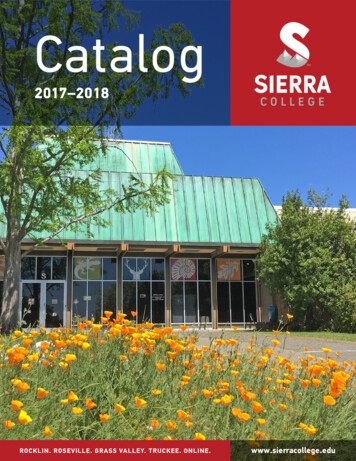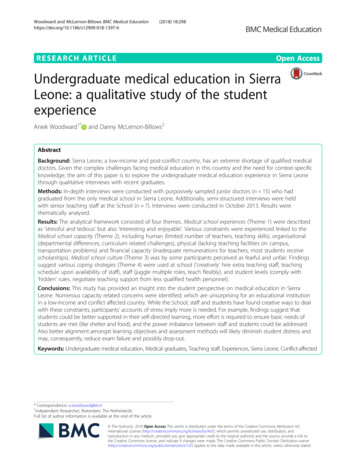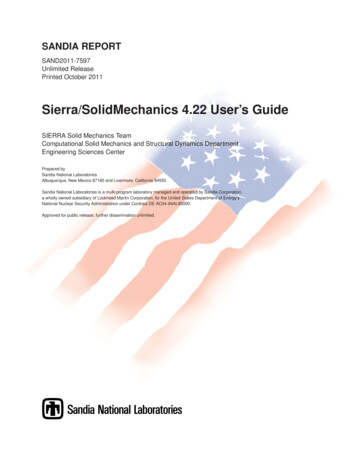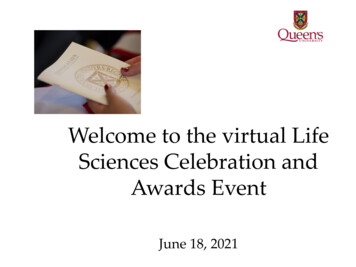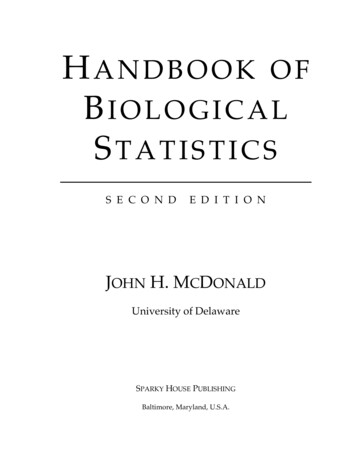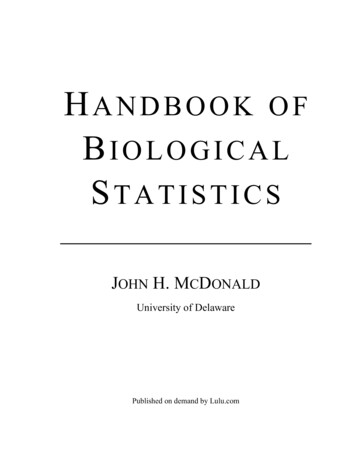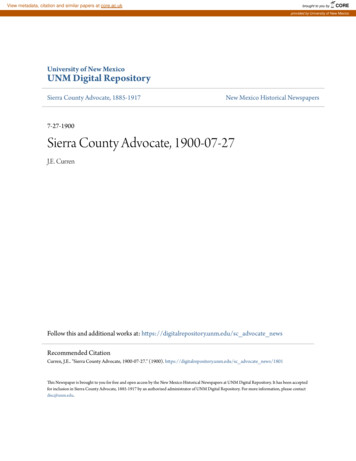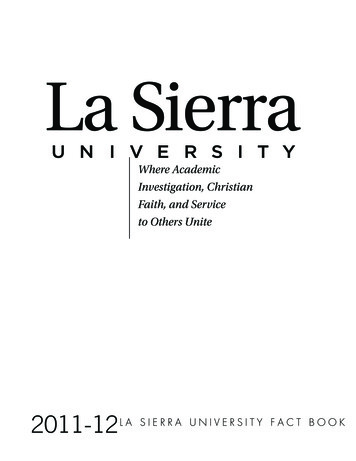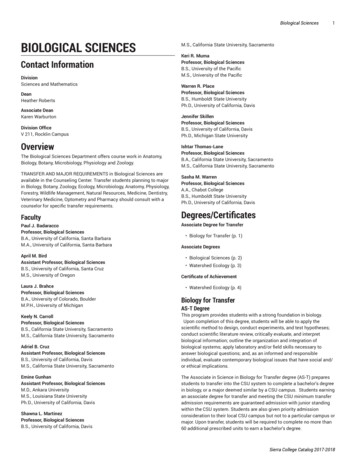
Transcription
Biological SciencesBIOLOGICAL SCIENCESContact InformationDivisionSciences and MathematicsDeanHeather RobertsAssociate DeanKaren WarburtonDivision OfficeV 211, Rocklin CampusOverviewThe Biological Sciences Department offers course work in Anatomy,Biology, Botany, Microbiology, Physiology and Zoology.TRANSFER AND MAJOR REQUIREMENTS in Biological Sciences areavailable in the Counseling Center. Transfer students planning to majorin Biology, Botany, Zoology, Ecology, Microbiology, Anatomy, Physiology,Forestry, Wildlife Management, Natural Resources, Medicine, Dentistry,Veterinary Medicine, Optometry and Pharmacy should consult with acounselor for specific transfer requirements.FacultyPaul J. BadaraccoProfessor, Biological SciencesB.A., University of California, Santa BarbaraM.A., University of California, Santa BarbaraApril M. BirdAssistant Professor, Biological SciencesB.S., University of California, Santa CruzM.S., University of OregonLaura J. BrahceProfessor, Biological SciencesB.A., University of Colorado, BoulderM.P.H., University of MichiganKeely N. CarrollProfessor, Biological SciencesB.S., California State University, SacramentoM.S., California State University, SacramentoAdriel B. CruzAssistant Professor, Biological SciencesB.S., University of California, DavisM.S., California State University, SacramentoEmine GunhanAssistant Professor, Biological SciencesM.D., Ankara UniversityM.S., Louisiana State UniversityPh.D., University of California, DavisShawna L. MartinezProfessor, Biological SciencesB.S., University of California, Davis1M.S., California State University, SacramentoKeri R. MumaProfessor, Biological SciencesB.S., University of the PacificM.S., University of the PacificWarren R. PlaceProfessor, Biological SciencesB.S., Humboldt State UniversityPh.D., University of California, DavisJennifer SkillenProfessor, Biological SciencesB.S., University of California, DavisPh.D., Michigan State UniversityIshtar Thomas-LaneProfessor, Biological SciencesB.A., California State University, SacramentoM.S., California State University, SacramentoSasha M. WarrenProfessor, Biological SciencesA.A., Chabot CollegeB.S., Humboldt State UniversityPh.D., University of California, DavisDegrees/CertificatesAssociate Degree for Transfer Biology for Transfer (p. 1)Associate Degrees Biological Sciences (p. 2) Watershed Ecology (p. 3)Certificate of Achievement Watershed Ecology (p. 4)Biology for TransferAS-T DegreeThis program provides students with a strong foundation in biology.Upon completion of this degree, students will be able to apply thescientific method to design, conduct experiments, and test hypotheses;conduct scientific literature review, critically evaluate, and interpretbiological information; outline the organization and integration ofbiological systems; apply laboratory and/or field skills necessary toanswer biological questions; and, as an informed and responsibleindividual, evaluate contemporary biological issues that have social and/or ethical implications.The Associate in Science in Biology for Transfer degree (AS-T) preparesstudents to transfer into the CSU system to complete a bachelor’s degreein biology, or a major deemed similar by a CSU campus. Students earningan associate degree for transfer and meeting the CSU minimum transferadmission requirements are guaranteed admission with junior standingwithin the CSU system. Students are also given priority admissionconsideration to their local CSU campus but not to a particular campus ormajor. Upon transfer, students will be required to complete no more than60 additional prescribed units to earn a bachelor’s degree.Sierra College Catalog 2017-2018
2Biological SciencesTo earn the Associate in Science in Biology for Transfer degree, studentsmust complete 60 CSU-transferable semester units with a minimumgrade point average of 2.0, including both of the following: completion of all courses required for the major with grades of “C” orbetter; and completion of the Intersegmental General Education TransferCurriculum for Science, Technology, Engineering, andMathematics (IGETC for STEM) al-general-education-transfer-curriculum1igetc) pattern. (Students transferring to a CSU campus mustcomplete Area 1C Oral Communication to be eligible for admission.) One remaining lower-division general education course in Area 4; and One course in Area 6 for UC-bound students who have not satisfied therequirement through proficiency.Required CoursesBIOL 0001General BiologyBIOL 0002BotanyBIOL 0003General Zoology4.5CHEM 0001AGeneral Chemistry I (OR)5-644.5General Chemistry I - Part 1and General Chemistry I - Part 2CHEM 0001BGeneral Chemistry II5MATH 0016ACalculus for Social and Life Sciences4Analytical Geometry and Calculus IGeneral Physics Iand General Physics I Laboratoryand General Physics IIand General Physics II LaboratoryPHYS 0205& 0205L& PHYS 0210& PHYS 0210LPrinciples of Physics: Mechanicsand Principles of Physics Laboratory:Mechanicsand Principles of Physics: Electricityand Magnetismand Principles of Physics Laboratory:Electricity and MagnetismTotal Units(The deferred lower-division courses must be replaced with calculusand/or science courses that are required to be taken before transferto the university.)Biological SciencesAS DegreeRESTRICTION: International coursework from non-United Statesregionally accredited institutions cannot be applied to associate degreesfor transfer.PHYS 0105& 0105L& PHYS 0110& PHYS 0110L Two courses in Area 3 - one course in Area 3A and one course in Area 3B;and One remaining lower-division general education course in Area 3;It is highly recommended that, prior to transferring, students completecourses that satisfy the CSU United States History, Constitution andAmerican Ideals graduation requirement. In all cases, students shouldconsult with a counselor for more information on university admissionand transfer requirements.Select one of the following physics sequences: All courses in Areas 1 (except 1C for UC-bound students), 2, and 5 of thetraditional IGETC;The following deferred courses must be completed after transfer:The exact wording of the law pertaining to associate degrees for transfermay be found in Education Code Section 66746.or MATH 0030IGETC for STEM is only an option for students earning AS-T degreesin Biology for Transfer and/or Chemistry for Transfer. IGETC forSTEM certification requires the following courses before transfer: Two courses in Area 4 from two different disciplines.NOTE: The California State University General Education Breadth pattern(CSU GE) is NOT an option for this degree.or CHEM 0003A& CHEM 0003B19-10The Biological Science curriculum provides students with the opportunityto meet the requirements for transferring to four-year colleges in theareas of Agriculture, Animal Science, Biochemistry, Bioengineering,Biological Sciences, Biotechnology, Chiropractic, Clinical Lab Technician,Curator, Dental Hygiene, Dentistry, Environmental Studies, Forestry,Nutrition/Dietetics, Occupational Therapy, Plant Science, Pharmacy,Physical Therapy, Premedical, Nursing, Range Management, VeterinaryMedicine, Wildlife/Fisheries Biologist and Zoologist, or entry levelpositions in related fields. In all cases, students should consult with acounselor for more information on university admission and transferrequirements. Students must fulfill the following major requirementswith grades of “C” or better, complete a minimum of 60 degree-applicablesemester units (12 of which must be completed at Sierra College) witha grade point average of at least 2.0 and complete one of the followingthree general education patterns: Sierra College Associate Degree Requirements gree-requirements); California State University General Education Breadth nts) pattern; Intersegmental General Education Transfer Curriculum c).Required CoursesSelect 12-15 units from the following:36-38BIOL 0001General BiologyBIOL 0002BotanyBIOL 0003General ZoologyBIOL 0004Microbiology (OR)or BIOL 0008A Microbiology I& BIOL 0008B and Microbiology IIBIOL 0005Human Anatomy (OR)or BIOL 0007A Human Anatomy I& BIOL 0007B and Human Anatomy IIBIOL 0006Sierra College Catalog 2017-2018Human Physiology12-15
3Biological SciencesSelect 8-11 units from the following courses or unusedcourses from the previous area:CHEM 0001A8-11General Chemistry I (OR)or CHEM 0003A General Chemistry I - Part 1& CHEM 0003B and General Chemistry I - Part 2CHEM 0001BGeneral Chemistry IICHEM 0002AIntroduction to Chemistry ICHEM 0002BIntroduction to Chemistry IIESCI 0001Physical GeologyMATH 0012College AlgebraMATH 0013Elementary StatisticsMATH 0016ACalculus for Social and Life SciencesMATH 0016BCalculus for Social and Life SciencesMATH 0027TrigonometryMATH 0029Pre-Calculus MathematicsMATH 0030Analytical Geometry and Calculus IMATH 0042Business CalculusPHYS 0105& 0105LGeneral Physics Iand General Physics I LaboratoryPHYS 0110& 0110LGeneral Physics IIand General Physics II LaboratoryPHYS 0205& 0205LPrinciples of Physics: Mechanicsand Principles of Physics Laboratory:MechanicsPHYS 0210& 0210LPrinciples of Physics: Electricity andMagnetismand Principles of Physics Laboratory:Electricity and MagnetismSelect a minimum of .5 units from the following:BIOL 0016ALocal Ecosystems of Placer CountyBIOL 0016BLocal Ecosystems of Nevada CountyBIOL 0016CVernal Pools and the California PrairieBIOL 0016DBiology of Waterfowl and Marsh BirdsBIOL 0016EEcology of the Sierran Conifer ForestBIOL 0016GField Paleontology and AncientEnvironmentsBIOL 0016HEcology of the Mendocino CoastBIOL 0016IBiology of Mono Lake and the GreatBasinBIOL 0016JEcology of Point Reyes NationalSeashoreBIOL 0016KFoothill Ecology of the Sierra NevadaBIOL 0016LAquatic and Riparian Environments ofCalifornia WaterwaysBIOL 0016MMarine Mammals and BirdsBIOL 0016NEcology of the Modoc PlateauBIOL 0016OEcology of the High Sierra and WhiteMountainBIOL 0016PDeath Valley and Desert EcosystemsBIOL 0016QEcology of Mid-Western North AmericaBIOL 0016RCanyon Lands of the SouthwestBIOL 0016TCoastal Habitats of Northern CaliforniaBIOL 0016UCoastal Habitats of Central CaliforniaBIOL 0016VDeserts of Southern CaliforniaBIOL 0016WBiology/Ecology of the Klamath and theSouthern CascadeBIOL 0016YEcology of Selected WildernessEcosystemsBIOL 0016ZEcology of the American RiverBIOL 0023Wildflower IdentificationTotal Units20.5-30Recommended ElectivesCSCI 0010or CSCI 0050ESS 0001Introduction to Computing3Introduction to Unix/LinuxThe Environment and the HumanImpact3Watershed EcologyAS DegreeThe Watershed Ecology Technician’s (WET) program offers coursesleading to an associate in science degree. Watershed ecology includesthe study of all aspects of the environment including organisms withinan entire watershed-the land area draining into the major creeks and riversystems. The program can serve as the basic preparation for entry-levelpositions with organizations and governmental agencies that performa variety of environmental studies. Students must fulfill the followingmajor requirements with grades of “C” or better, complete a minimum of60 degree-applicable semester units (12 of which must be completed atSierra College) with a grade point average of at least 2.0 and completeone of the following three general education patterns:.5-4 Sierra College Associate Degree Requirements gree-requirements); California State University General Education Breadth nts) pattern; Intersegmental General Education Transfer Curriculum c).Required CoursesBIOL 0001or BIOL 0011General Biology4Concepts of BiologyBIOL 0013Field Methods in Ecology3BIOL 0014Natural History, Ecology andConservation (also ESS 0014)4BIOL 0095Internship in Biological Sciences1ESS 0013Environmental Regulations1GEOG 0090Introduction to Geographic InformationSystems (GIS)4Select 9-12 units from any of the following emphases:19-12Animal Study EmphasisBIOL 0003General ZoologyBIOL 0016DBiology of Waterfowl and Marsh BirdsBIOL 0016MMarine Mammals and BirdsBIOL 0030Introduction to OrnithologyBIOL 0033Introduction to ZoologyBIOL 0035Introduction to EntomologySierra College Catalog 2017-2018
4Biological SciencesBIOL 0036Introduction to MammalogyPlant Study EmphasisVernal Pools and the California PrairieBIOL 0016EEcology of the Sierran Conifer ForestBIOL 0002BotanyBIOL 0023Wildflower IdentificationBIOL 0016CVernal Pools and the California PrairieBIOL 0024BIOL 0016EEcology of the Sierran Conifer ForestWildland Trees and Shrubs(Dendrology)BIOL 0023Wildflower IdentificationBIOL 0024Wildland Trees and Shrubs(Dendrology)General EmphasisGeneral EmphasisAGRI 0221Introduction to Soil ScienceBIOL 0016ALocal Ecosystems of Placer CountyESS 0001The Environment and the HumanImpactAGRI 0221Introduction to Soil ScienceBIOL 0016ALocal Ecosystems of Placer CountyGEOG 0001Physical GeographyESS 0001The Environment and the HumanImpactMATH 0013Elementary StatisticsGEOG 0001Physical GeographyMATH 0013Elementary StatisticsTotal Units1Total Units1BIOL 0016C26-29Only 3 units total may be taken from the BIOL 0016 field studycourses. Courses are grouped according to specific interests, butstudents are not limited to a specific emphasis. Students opting totake BIOL 0001 are advised to consult with a counselor regardingpre/corequisites.Understanding course descriptions ng-course-descriptions)Certificate of AchievementWatershed ecology includes the study of all aspects of the environmentincluding organisms within an entire watershed-the land area draininginto the major creeks and river systems. The certificate program canserve as the basic preparation for entry-level positions with organizationsand governmental agencies that perform a variety of environmentalstudies. A certificate is designed to provide career technical skills; it isnot equivalent to an associate degree.Required Coursesor BIOL 0011General Biology4Concepts of BiologyBIOL 0013Field Methods in Ecology3BIOL 0014Natural History, Ecology andConservation (also ESS 0014)4BIOL 0095Internship in Biological Sciences1ENGL 0001AIntroduction to Composition3or ENGL 0012Writing in the WorkplaceESS 0013Environmental Regulations1GEOG 0090Introduction to Geographic InformationSystems (GIS)4Select 9-12 units from any of the following emphases:1Animal Study EmphasisBIOL 0003General ZoologyBIOL 0016DBiology of Waterfowl and Marsh BirdsBIOL 0016MMarine Mammals and BirdsBIOL 0030Introduction to OrnithologyBIOL 0033Introduction to ZoologyBIOL 0035Introduction to EntomologyBIOL 0036Introduction to MammalogyPlant Study EmphasisBIOL 0002BotanySierra College Catalog 2017-2018Only 3 units total may be taken from the BIOL 0016 field studycourses. Courses are grouped according to specific interests, butstudents are not limited to a specific emphasis. Students opting totake BIOL 0001 are advised to consult with a counselor regardingpre/corequisites.CoursesWatershed EcologyBIOL 000129-329-12BIOL 0001. General BiologyUnits: 4Prerequisite: Completion of CHEM 1A, CHEM 3A/3B, or higher levelchemistry course with grade of "C" or better; AND completion of MATH Dor equivalent with grade of "C" or better; AND eligibility for ENGL 11Advisory: Eligibility for ENGL 1AHours: 108 (54 lecture, 54 laboratory)First course in the General Biology sequence for biology majors andpre-allied health students. Covers general biological concepts, with anemphasis on cellular and molecular biology, genetics, and evolution. (C-IDBIOL 190) (CSU, UC)BIOL 0002. BotanyUnits: 4.5Prerequisite: Completion of BIOL 1 with grade of "C" or better; ANDcompletion of MATH D or equivalent with grade of "C" or betterAdvisory: Eligibility for ENGL 1AHours: 144 (54 lecture, 90 laboratory)Introduction to botany, including classification, morphology, anatomy,physiology, diversity, ecology, and evolution emphasizing members of theKingdoms Plantae, Fungi, Protista, and Prokaryotae. Topics relating toflowering plants stressed. Correlation of topics with scientific methodand modern biological research. Non-life science majors see BIOL 14. (CID BIOL 155) (CSU, UC)
Biological SciencesBIOL 0003. General ZoologyUnits: 4.5Prerequisite: Completion of BIOL 1 or BIOL 33 with grade of "C" or better;AND completion of MATH D or equivalent with grade of "C" or betterAdvisory: Eligibility for ENGL 1AHours: 144 (54 lecture, 90 laboratory)Detailed survey of the animal kingdom stressing evolution and ecologyof animals and functional anatomy of their major organ systems.Recommended for life science majors, premedical, preveterinary andrelated professional programs. (C-ID BIOL 150) (CSU, UC-with unitlimitation)BIOL 0004. MicrobiologyUnits: 5Prerequisite: Completion of high school chemistry, CHEM A, or higherlevel chemistry course with grade of "C" or betterAdvisory: Eligibility for ENGL 11 strongly recommendedHours: 162 (54 lecture, 108 laboratory)Introduction to the biochemistry, morphology, physiology, genetics,and classification of microorganisms. Emphasis on the significance ofmicroorganisms to human health and global ecology. Laboratory topicsinclude traditional and modern techniques of microbial classification,recombinant DNA technology, and bacteriophage biology. Studentsenrolling in BIOL 4 after having taken BIOL 8A will lose credit for BIOL 8A.(CSU, UC-with unit limitation)BIOL 0005. Human AnatomyUnits: 4Prerequisite: Eligibility for ENGL 11Advisory: Completion of BIOL 55, 56, HSCI 3, or previous science coursewith grade of "C" or better, or experience in health care field; completion ofMATH D with grade of "C" or better; eligibility for ENGL 1AHours: 108 (54 lecture, 54 laboratory)Structural organization, relationships among structures, and histology ofthe human body: gross and microscopic structure of the integumentary,skeletal, muscular, nervous, endocrine, cardiovascular, lymphatic,respiratory, digestive, urinary and reproductive systems, from cellular toorgan system levels of organization. This is a rigorous course in humananatomy primarily intended for nursing, allied health, kinesiology, andother health related majors. Cadaver prosections used for instruction.Nonmajors see BIOL 55, 56, and 56L. Students enrolling in BIOL 5 afterhaving taken BIOL 7A will lose credit for BIOL 7A. (C-ID BIOL 110B) (CSU,UC-with unit limitation)BIOL 0005X. Success in AnatomyUnit: 1Corequisite: Concurrent enrollment in BIOL 5Hours: 18 lectureOptional course for students concurrently enrolled in BIOL 5 to gain adeeper understanding of course material through discussions focused onanatomical concepts, terminology, and the implementation of anatomicalknowledge to clinical and problem solving situations. Advanced studytechniques, necessary for success in science courses, are modeled tostrengthen student self-awareness, confidence, and ability to monitorlearning. (CSU)5BIOL 0006. Human PhysiologyUnits: 5Prerequisite: Completion of CHEM 2A or 1A or 3A/3B; AND BIOL 5 or7A/7B or 55 with grades of "C" or betterAdvisory: Completion of MATH D with grade of "C" or better; completionof a non-majors general biology course with grade of "C" or better; andeligibility for ENGL 1AHours: 126 (72 lecture, 54 laboratory)Study of the physiology, integration, and homeostasis of the humanbody from chemical through organism levels. Organ systems coveredare integumentary, muscular, nervous, sensory, cardiovascular, lymphaticand immune, respiratory, urinary, digestive, endocrine, and reproductivesystem. Experiments using living and non-living models are performed inlab using methods of data acquisition, recording systems, and analysisof data. Primarily intended for Nursing, Allied Health, Kinesiology, andother health or life science majors. (C-ID BIOL 120B) (CSU, UC-with unitlimitation)BIOL 0007A. Human Anatomy IUnits: 2.5Prerequisite: Eligibility for ENGL 11Advisory: Completion of BIOL 55, 56, HSCI 3, or previous science coursewith grade of "C" or better, or experience in health care field; completion ofMATH D with grade of "C" or better; eligibility for ENGL 1AHours: 72 (36 lecture, 36 laboratory)Structure, relationships among structures, and histology of the humanbody from cellular to organ system levels of organization. Includesintegumentary, skeletal, nervous, and sensory systems. Cadaverprosections are used for instruction. The sequence of BIOL 7A/7B isequivalent to BIOL 5. Students enrolling in BIOL 5 after having taken BIOL7A will lose credit for BIOL 7A. (combined with BIOL 7B, C-ID BIOL 110B)(CSU, UC-with unit limitation)BIOL 0007B. Human Anatomy IIUnits: 2.5Prerequisite: Completion of BIOL 7A with grade of "C" or betterHours: 72 (36 lecture, 36 laboratory)Structure, relationships among structures, and histology of the humanbody from cellular to organ system levels of organization. Includesmuscle, cardiovascular, lymphatic, endocrine, respiratory, digestive,urinary and reproductive systems. Cadaver prosections are used forinstruction. The sequence of BIOL 7A/7B is equivalent to BIOL 5.(combined with BIOL 7A, C-ID BIOL 110B) (CSU, UC-with unit limitation)BIOL 0008A. Microbiology IUnits: 2.5Prerequisite: Completion of high school chemistry, CHEM A, or higherlevel chemistry course with grade of "C" or betterAdvisory: Eligibility for ENGL 11 strongly recommendedHours: 81 (27 lecture, 54 laboratory)Introduction to the biochemistry, morphology, classification andphysiology of microorganisms, especially bacteria. Emphasis on thesignificance of microorganisms to human health and global ecology. Thesequence of BIOL 8A/8B is equivalent to BIOL 4. Students enrolling inBIOL 4 after having taken BIOL 8A will lose credit for BIOL 8A. (CSU, UCwith unit limitation)Sierra College Catalog 2017-2018
6Biological SciencesBIOL 0008B. Microbiology IIUnits: 2.5Prerequisite: Completion of BIOL 8A with grade of "C" or betterAdvisory: Eligibility for ENGL 11 strongly recommendedHours: 81 (27 lecture, 54 laboratory)Introduction to microbial genetics and metabolic regulation, viruses,microbial control, host defense, immunization, epidemiology,mechanisms of pathogenicity, and significance of microorganisms,especially bacteria and viruses. Emphasis on the significance ofmicroorganisms to human health and global ecology. Laboratory topicsinclude traditional and modern techniques of microbial classification,recombinant DNA technology, and bacteriophage biology. The sequenceof BIOL 8A/8B is equivalent to BIOL 4. CSU, UC-with unit limitation)BIOL 0010. Introduction to BiologyUnits: 3Advisory: Eligibility for ENGL 1AHours: 54 lectureDesigned for non-life science majors desiring an introductory biologycourse without a lab. Introduces the main concepts of biology, coveringmolecular and cell biology, heredity and nature of genes, biotechnology,evolution, diversity of life, and principles of ecology. Students enrolling inBIOL 11 after having taken BIOL 10 will lose credit for BIOL 10. (CSU, UCwith unit limitation)BIOL 0011. Concepts of BiologyUnits: 4Advisory: Eligibility for ENGL 1A and MATH 12Hours: 108 (54 lecture, 54 laboratory)Designed for non-life science majors desiring an introductory biologycourse with a lab. Introduces the main concepts of biology, coveringmolecular and cell biology, heredity and nature of genes, biotechnology,evolution, diversity of life, and principles of ecology. Students enrollingin BIOL 11 after having taken BIOL 10 will lose credit for BIOL 10. Notrecommended for students who have completed BIOL 56 and 56L. (CSU,UC-with unit limitation)BIOL 0013. Field Methods in EcologyUnits: 3Formerly known as BIOL 13BAdvisory: Completion of BIOL 14 strongly recommendedHours: 90 (36 lecture, 54 laboratory)Introduction to methods for sampling and studying environmentalparameters of ecosystems and organisms. Identification of microscopicand macroscopic organisms, quantitative and qualitative field researchtechniques and procedures applicable to environmental assessment andpopulation monitoring. Field trips required. (CSU)BIOL 0014. Natural History, Ecology and ConservationUnits: 4Also known as ESS 0014Advisory: Eligibility for ENGL 0001AHours: 108 (54 lecture, 54 laboratory)Introduction to the study of biology and ecology of organisms andecosystems of the world, with an emphasis on California. Special focuson significance of functioning ecosystems and human influence onbiological environment. (CSU, UC)Sierra College Catalog 2017-2018BIOL 0015. Marine BiologyUnits: 4Advisory: Eligibility for ENGL 11Hours: 108 (54 lecture, 54 laboratory)Introduction to basic biological and ecological principles of majorsaltwater environments. Stresses conservation and appropriateutilization of marine resources. Designed for both science and nonscience majors. Laboratory hours partially fulfilled by required fieldtrips. Hiking and boat travel may be necessary. Camping and entrancefees may be required. Students may be required to provide their owntransportation on field trips. (CSU, UC)BIOL 0016A. Local Ecosystems of Placer CountyUnits: 0.5Hours: 13 (7 lecture, 6 laboratory)Field study that introduces local natural areas and their inhabitants.Selected ecosystems in Placer County are investigated in the field toidentify and study the characteristic plants and animals and discovertheir relationships with the physical environment. Students may berequired to provide their own transportation. (CSU)BIOL 0016B. Local Ecosystems of Nevada CountyUnits: 0.5Hours: 13 (7 lecture, 6 laboratory)Field study that introduces local natural areas and their inhabitants.Selected ecosystems within Nevada County are investigated in thefield to identify and study the characteristics of plants and animals anddiscover their relationships with the physical environment. Students maybe required to provide their own transportation. (CSU)BIOL 0016C. Vernal Pools and the California PrairieUnits: 0.5Hours: 13 (7 lecture, 6 laboratory)Field study that explores the ecological past, present, and future ofCalifornia's Great Valley ecosystems. Emphasis on remaining naturalareas and conservation efforts. Special attention given to grasslandsand vernal pool habitats. Students may be required to provide their owntransportation. (CSU)BIOL 0016D. Biology of Waterfowl and Marsh BirdsUnits: 0.5Hours: 13 (7 lecture, 6 laboratory)Field identification and observation of marsh birds (primarily ducks,geese, swans, and wading birds). Includes general waterfowl biology andecology. Emphasizes evolution, migration, reproductive cycles, currentpopulation trends, and habitat needs. Operational needs and conflicts ofnational and local wildlife refuge system are discussed. Students mayneed to provide their own transportation. (CSU)BIOL 0016E. Ecology of the Sierran Conifer ForestUnits: 0.5Hours: 13 (7 lecture, 6 laboratory)Field study that introduces forest biology/ecology, emphasizinginterrelationships between the Sierran forest inhabitants (animals, plants,fungi) and their environment. Study sites include a variety of forestand other associated mountain ecological communities. Depending onseason offered, special topics may include: fungi biology, wildflowerecology, tree anatomy and physiology, forest nutrient cycles, forestbirds, and soil organisms. Students may be required to provide their owntransportation. (CSU)
Biological SciencesBIOL 0016G. Field Paleontology and Ancient EnvironmentsUnits: 1-4Also known as ESCI 16GHours: 30 (12 lecture, 18 laboratory) per unitInvestigations into the ecology of environments in the geologic pastthrough field work at fossil sites. Comparisons/contrasts made betweenancient (fossil) communities and the current (living) communities ofselected study sites. Differences and similarities between the plants andanimals used as evidence to reconstruct ancient ecological communities.Students may be required to provide their own transportation. (CSU)BIOL 0016H. Ecology of the Mendocino CoastUnit: 1Hours: 30 (12 lecture, 18 laboratory)Field study examining the Northern California Coast and its diverseecological environments. Using the Fort Bragg/Mendocino/Fort Rossareas, investigates the biological relationships found in: the redwood,riparian, pygmy, mixed evergreen and closed-cone pine forests, and theshoreline communities of tidepool, sandy beach, dune, prairie and scrub.Plants, animals, environmental factors and effects of human activities areassessed for each of the ecological communities examined. Hiking maybe necessary. Camping and entrance fees may be required. Students maybe required to provide their own transportation. (CSU)BIOL 0016I. Biology of Mono Lake and the Great BasinUnit: 1Hours: 30 (12 lecture, 18 laboratory)Field study investigating the natural history and ecology of the GreatBasin with special emphasis on Mono Lake and the Mono Basin.Examines physical, biological, historical, and ecological aspects thatmake the Mono Basin unique. Emphasis on biological and ecologicalaspects of the Mono Basin. Students may be required to provide theirown transportation. (CSU)BIOL 0016J. Ecology of Point Reyes National SeashoreUnit: 1Hours: 30 (12 lecture, 18 laboratory)Field study exploring the coastal mosaic of Point Reyes NationalSeashore and vicinity. Usi
Curator, Dental Hygiene, Dentistry, Environmental Studies, Forestry, Nutrition/Dietetics, Occupational Therapy, Plant Science, Pharmacy, Physical Therapy, Premedical, Nursing, Range Management, Veterinary Medicine, Wildlife/Fisheries Biologist and Zoologist, or entry level positions in related fields. In all cases, students should consult with a
